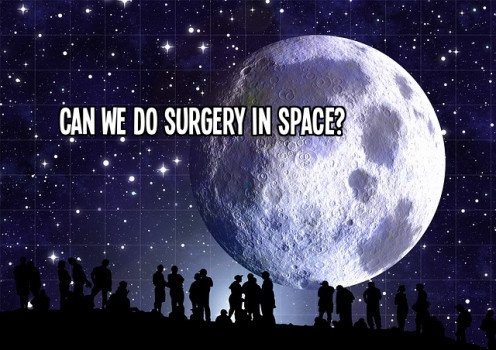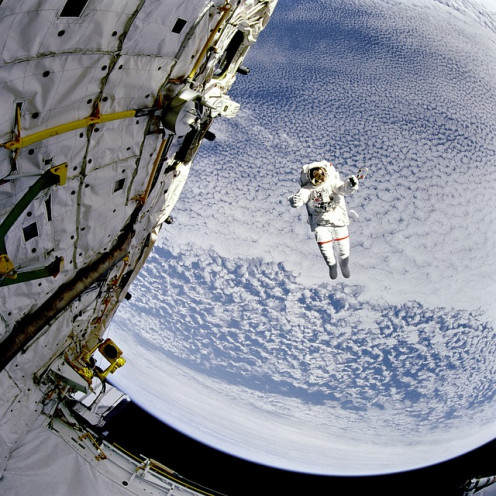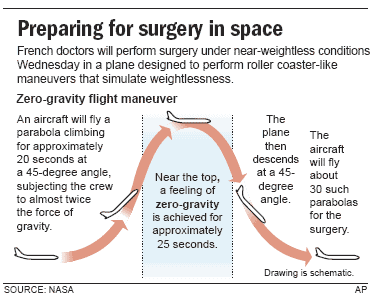Medicine and Surgery in Outer Space

Space Medicine Needs to Become Visible
By the year 2016, astronauts, cosmonauts and other -nauts were spending as long as 6 to 12 months in the International Space Station.
No one broke bones or needed surgery at that station, but all needed time to readjust to Earth's gravity. Upon each return from the ISS, the space explorers required bed rest in order to readjust to Terra, at the rate of about a time equal to that spent in space for the 6-month sojourners.
In 2014 - 2015, a crew of astronauts were first scheduled to spend a full 12 months in the ISS. Medical emergencies and surgeries need to be considered as real possibilities from that mission forward, whether they involve an infected appendix or an infected tooth. We await the results of the twin study involving the Kelly Brothers, one of whom served 12 months in the ISS ending in March 2016.
By January 2015, NASA had developed technology and spacecraft that could reach Mars from Earth in only 3 days or 72 hours.

Early Mars Expedition
In 2018, a heterosexual couple is to be the experimental first people on Mars. Even if it turns out that they can only do a flyby, the length of time required to journey out there and back might contain some medical emergencies. beyond the help of a First Aid kit.
Planetary Resources, Inc. plans to mine asteroids near Earth in the 2010s and between Mars and Jupiter before 2035. Next steps take space tourism to a moon of Jupiter that might be habitable. All that will likely keep humankind busy until 2200, the time setting of the original Star Trek™ series.
People in space will need physical and psychological medical care, including surgeries. For intance, appendicitis cannot wait until an opportunity window opens for a space flight back to Earth. Broken bones sometimes need plates, wires, and screws. Unforecasted emergencies and conditions will surprise us as well.
Space Medicine has been a segment of the medical profession studied quietly in universities, but now it needs to become visible.
University of Cincinnati doctors practice simulated surgery on mannequins in weightless conditions in a DC-9, especially using robotic equipment.
Surgery and Blood in Space
Space Medicine became a part of preventive medicine and public health in the mid-to-late 1990s and we heard a lot about long-term space travel and its resultant effects on the human body. These effects include much-lowered blood pressure, loss of bone mass, muscle atrophy, and similar deficiencies.
In the late 2000s, it became clear to public and private space agencies that physical and mental health concerns in outer space would require attention, including that of surgeons. AS late as 2011 and 2012, some experts felt that blood and other body fluids involved in surgery could not be contained in outer space on spacecraft or the International Space Station - surgery patients would need to be returned to Earth. However, in a case of appendicitis, such a return would likely be fatal, because of time constraints.
Suggestions have been made that all astronauts have appendectomies before space travel, but this entails unnecessary surgery.
We have heard about surgeons performing self-surgery in Antarctica - one in 1961 by a male surgeon for appendectomy and in more recent years by a female doctor who suspected cancer and performed a biopsy on herself. These cases show us that the same conditions can happen anywhere in isolation, in the Antarctic or in space.
The problem of containing blood and other fluids during space surgery was addressed after 2010.
In 2012, biomedical engineers and surgeons from Carnegie Mellon University joined those at the University of Louisville to create surgical tools and blood containment methods for use on space missions to the moon, near-Earth asteroids, and Mars.
This is good timing, since the NASA astronaut class of 2013 will be flying those missions between 2013 - 2030.
- Video Credit: University of Louisville - YouTube
Dr. George Pantalos of U of L's Cardiovascular Innovation Institute is at work now developing the technology that is expected to make "astro surgery" possible on the extended space flights of the future.
Surgery In Antarctica
Surgeon Leonid Rogozov was assigned to the new Soviet base in Antarctica and suffered appendicitis in 1961.
He could not get out of the area to a hospital, so he administered local anesthesia. with the help of two other scientists, he removed his own appendix. -- from the British Medical Journal 2009; 339, b4965.
This resourceful man lived 30 years after his own surgery.
Biopsy In Antarctica
Ohioan Dr. Jerri Nielsen, played by Susan Sarandon in a made-for-television movie, lived only 10 years after performing her own biopsy in Antarctica. At age 47 in 1999, she treated herself with chemotherapy beginning in June at America's Amundsen-Scott South Pole Research Station. The only doctor on site, she waited until November to be airlifted out. Meanwhile, she received assistance for her own care through email and teleconferencing.
Nielsen recovered fully, but in 2005, cancer was found in her liver, bones, and then the brain. At age 57, she died in June 2009.
French Surgeons Practice In Weightlessness

The Star Trek Surgical Cover
Star Trek: The Net Generation (1987 - 1994) featured several episode scenes in which surgery was done under a protective box-like covering, with surgeons wearing no masks. In 2013, we have the covering developed, but surgeons still need to wear masks.
James Antaki, in biomedical engineering at CMU and George M. Pantalos in surgery and bioengineering at U of L. along with CMU scientists James E. Burgess and Jennifer A. Hayden are responsible for the watertight surgery system, first conceptualized by Burgess. It isolates the surgical cut or a wound and controls bleeding with a pressurized saline solution environment (like the sterile saline in an IV bag). Star Trek did not use water or any liquid, just the box.
The control system was tested in zero-G conditions several times on the so-called Vomit Comet plane at the Johnson Space Center in the autumn of 2012 and found workable. Several advanced graduate students received the chance to try simulated surgical techniques at zero-G (see the accompanying video).
If our new astronauts suffer appendicitis, gall bladder attacks, broken bones requiring surgery, or teeth requiring extraction, or cuts that need suturing, they should all be treatable in space.

Sources
The Ohio State University, College of Medicine and Public Health
- Courses and public lectures presented from 1990 - 2017.
Space surgeons : Johns Hopkins University in The Gazette
- Dec 5, 2011 – Space surgeons. Medical robotics experts help advance NASA's 'satellite surgery' project.
Surgery in Space - Carnegie Mellon University | CMU
- August 27, 2012 -- Surgical care in zero gravity would be a challenge.
Pittsburgh Researchers Prepare for Space Surgery - Pittsburgh Post
- September 2012 - Surgery cover for use in space was first thought of in 2003.
Blood in Zero Gravity: NASA Tries to Prepare for Surgery in Space
- October 2012 – Zero gravity and bodily fluids are a dangerous combination.
Zero-gravity tool makes surgery in space possible | SmartPlanet
- October 2012 – In space, blood and bodily fluids were thought to be incapable of being contained during surgery. For any medical emergencies, astronauts were to be evacuated to Earth; but, this would take too long.

© 2013 Patty Inglish MS



